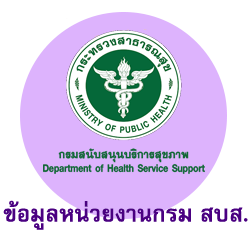The pre valence of Carbapenem Resistant Enterobacteriaceae in Mukdahan Hospital
Keywords:
Infection, Antimicrobial resistance, Carbapenem ResistantAbstract
The carbapenem resistant Enterobacteriaceae (CRE) prevalence is increasing around the world. The CRE infection causes limitations in the treatment because it is resistant to many groups of drugs. Resulting in patients being at risk of complications and higher mortality. This study is a retrospective study. The objective of this study was to study the prevalence and trend of CRE isolated from patients who were admitted in Mukdahan Hospital during 2016-2018 as a guideline for a campaign to control anti-microbial resistance for better quality. Enterobacteriaceae of 3,663 cases, found that 1,289 cases were resistant to 3rd cephalosporins and all CRE were 54 (1.5%). Studies show that CRE is increasing every year with 1.1, 1.5 and 1.8% respectively. The most CRE was found in the medical ward (2.4%) and most of the male (55%). They were most isolated from urine (2.3 %) and following isolated rate was from sputum (1.8 %), pus (1.2 %) and blood (1.0 %), respectively. K. pneumoniae infection were most CRE 2.5%, followed by Enterobacter spp., and E.coli 1.8% and 1.2% respectively. The CRE infection rate was increasing every years, therefore, it is very important that the hospital AMR surveillance working group should work together to assess review and restore knowledge of infection prevention and control to staff at all levels have common awareness. To solve the problem of drug resistance in hospitals to be effective.
References
Atipookanok, S., Wittawatmongkol, O. Guideline for Antibacterial Prophylaxis Administration in Pediatric Cancer and Hematopoietic Stem Cell Transplantation. Retrieved February 10,2020, from http://pidst.or.th/A786.html (in Thai)
Codjoe, F., & Donkor, E. (2018). Carbapenem resistance: A review. Medical Sciences. 6(1):1-28
Edwards, S. J., Emmas, C. E., & Campbell, H. E. (2005).Systematic review comparing meropenem with imipenem plus cilastatin in the treatment of severe infections Current medical research and opinion. 21(5): 785–794
Falagas, M. E., Tansarli, G. S., Karageorgopoulos, D. E., & Vardakas, K. Z. (2014). Deaths attributable to carbapenem-resistant Enterobacteriaceae infections. Emerging infectious diseases. 20(7): 1170-1175.
Hawkey, P. M., & Livermore, D. M. (2012). Carbapenem antibiotics for serious infections. Bmj. 344:43-47.
Khantee, P., Chokephaibulkit, K. Update of Carbapenem-Resistant Enterobacteriaceae.Retrieved March 20, 2019, from http://www.pidst.or.th/A464.html (in Thai)
Kiratisin,P. (2016). Textbook of Medical Bacteriology.3rd ed. Bankok: V.J.Printing Press. (in Thai).
Lesho, E. P., Clifford, R. J., Chukwuma, U., Kwak, Y. I.,Maneval, M., Neumann, C., McGann, P. (2015). Carbapenem-resistant Enterobacteriaceae and the correlation between carbapenem and fluoroquinolone usage and resistance in
the US military health system. Diagnostic microbiology and infectious disease. 81(2):119–125.
Livermore, D. M. (2002). Multiple mechanisms of antimicrobial resistance in Pseudomonas aeruginosa: Our worst nightmare? Clinical infectious diseases. 34(5): 634–640.
Luvira, V. (2006). Overveiw of antibiotic resistance. Songklanagarind Medical Journal. 24(5): 453–459. (in Thai)
NARST : National Antimicrobial Resistance Surveillance Center, THAILAND. Retrieced March 20, 2019, from http://narst.dmsc.moph.go.th/data/map2561.pdf (in Thai)
Phumart P, Phodha T, Thamlikitkul V, Riewpaiboon A, Prakongsai P, Limwattananon S. (2012). Health and Economic Impacts of Antimicrobial Resistant Infections in Thailand : A Preliminary Study. Jornal of Health Systems Research. 6(3):352-360. (in Thai)
Sumpradit, N., Wongkongkathep, S., Poonpolsup,S., Janejai, N., Paveenkittiporn. W., Boonyarit,P., Jaroenpoj, S., Kiatying-Angsulee, N.,Kalpravidh, W., Sommanustweechai, A., & Tangcharoensathien, V. (2017). New chapter in tackling antimicrobial resistance in Thailand. BMJ. 358:j3415.
Thongkoom, P., Kanchanahareutai, S.,Chantrakooptungkul, S., Rahule, S.,Pupan, M., Tuntrakul, P., Masan, N., &
Teammongkolrat, L.. (2017). CarbapenemResistant Enterobacteriaceae at Rajavithi Hospital: Results of a Microbiology Laboratory Program (2009-2015). Journal of Medical Association of Thailand. 100(1): 212-220. (in Thai)
Wiener, J., Quinn, J. P., Bradford, P. A., Goering, R. V.,Nathan, C., Bush, K., & Weinstein, R. A. (1999). Multiple antibiotic–resistant Klebsiella and Escherichia coli in nursing homes. JAMA.281(6): 517–523.
Downloads
Published
How to Cite
Issue
Section
License

This work is licensed under a Creative Commons Attribution-NonCommercial-NoDerivatives 4.0 International License.



